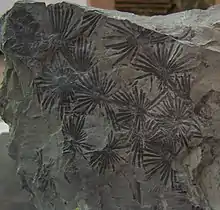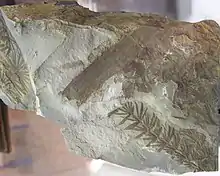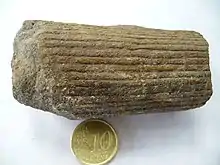| Calamitaceae | |
|---|---|
 | |
| Annularia stellata | |
| Scientific classification | |
| Kingdom: | Plantae |
| Clade: | Tracheophytes |
| Division: | Polypodiophyta |
| Class: | Polypodiopsida |
| Subclass: | Equisetidae |
| Order: | Equisetales |
| Family: | †Calamitaceae Unger, 1840 |
| Genera | |
|
See text | |
Calamitaceae is an extinct family of plants from the Carboniferous to Late Jurassic or Early Cretaceous[1] that were related to the modern horsetails.[2] Some members of this family attained tree-like stature during the Carboniferous Period (around 360 to 300 million years ago) and in Permian Period, reaching heights of up to 20 meters. The family takes its name from its principal genus Calamites.
Because some proposed species are based on partial fossil records, it is not clear if these are merely different parts of the same type.
The most recent record of the Calamitaceae is Neocalamites sp., which was found in the Late Jurassic-Early Cretaceous Kurnub Sandstone Formation of Egypt.[1]
Proposed genera and species of Calamitaceae

Asterophyllites equisetiformis
- Annularia.
- A. stellata.
- Arthropitys.
- Asterophyllites (or incorrectly Asterophyllum).
- Astromyelon.
- Calamites.
- C. carinatus.
- C. suckowi.
- C. undulatus.
- Calamocarpon.
- Calamostachys.
- C. binneyana.
- Cingularia.
- Mazostachys.
- Paleostachya.
References
- 1 2 J. H. A. van Konijnenburg-van Cittert and K. Bandel. (2001). Jurassic plants from Djebel Tih, Sinai. Mitt. Geol.-Paläont. Inst. Univ. Hamburg 85:47-64
- ↑ Elgorriaga, A.; Escapa, I.H.; Rothwell, G.W.; Tomescu, A.M.F.; Cúneo, N.R. (2018). "Origin of Equisetum: Evolution of horsetails (Equisetales) within the major euphyllophyte clade Sphenopsida". American Journal of Botany. 105 (8): 1286–1303. doi:10.1002/ajb2.1125. PMID 30025163.
External links
This article is issued from Wikipedia. The text is licensed under Creative Commons - Attribution - Sharealike. Additional terms may apply for the media files.
